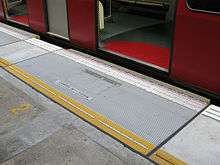Platform gap filler

Platform gap fillers are movable platform edge extensions at subway or train stations where the curvature of the platform creates a significant gap between the platform and subway or train car door.
In Singapore
Platform gap fillers are also used in the Mass Rapid Transit system of Singapore, namely the North South MRT Line and the East West MRT Line. Platform gap fillers are also planned for installation on trains on the North East MRT Line and the Circle MRT Line as well, because newer trains can be equipped with gap fillers.[1]
In Japan
Some Japanese railway stations also have platform gap fillers, called kadō steppu in Japanese.[2] Over 200 fillers are used in the Tokyo subway.[3]
New York City Subway
The Interborough Rapid Transit Company's first cars were built with only two doors on each side, at the extreme ends of the car, lining up with the curved platforms so as not to leave a wide gap between the train and the platform. When the IRT modified existing cars and ordered new cars with a middle door, gap fillers were needed because the middle door was not near the platform. After the City of New York bought the IRT in 1940, new car designs (starting with the R12) had the end doors away from the extreme ends of the carbody, which also required the use of gap fillers at certain stations.
Stations equipped
IRT stations with gap fillers are:
- South Ferry, outer loop.[4] The station closed on March 16, 2009 and was replaced by a new station which does not require gap fillers. After the latter station was damaged by flooding during Hurricane Sandy, the loop station was reopened as a temporary terminus on April 4, 2013. The 2009-era station will reopen when repairs are completed in 2017.
- Brooklyn Bridge – City Hall (IRT Lexington Avenue Line) originally had gap fillers on the express tracks. These were deactivated when the station was extended northward. These gap fillers are still in place and can be seen just south of the current platforms.[5]
- 14th Street – Union Square (IRT Lexington Avenue Line) has gap fillers on both tracks on the downtown platform.[6] There may have been gap fillers on the uptown express platform. A new design of gap filler was installed in 2004 to provide maintenance access from the platform rather than requiring crews to stand at track level.
- Times Square (IRT 42nd Street Shuttle) has them on Shuttle tracks 1 and 3. They are mounted under the platform rather than on it, so they are not ADA accessible.[7]
See also
References
- ↑ "'Gap fillers' on new trains to reduce platform gap". TODAYonline. 2015-05-14. Retrieved 2016-09-07.
- ↑ Gorrdenker, Alice. "Platform doors". Japan Times. Retrieved 29 November 2016.
- ↑ Gordenker, Alice (2012-01-17). "Platform doors". The Japan Times Online. ISSN 0447-5763. Retrieved 2016-09-07.
- ↑ "IRT West Side Line: South Ferry". 15 March 2009. Retrieved 2010-04-06.
- ↑ "IRT East Side Line: Brooklyn Bridge/City Hall". 2 January 2010. Retrieved 2010-04-06.
- ↑ "IRT East Side Line: 14th Street/Union Square". 24 June 2005. Retrieved 2010-04-06.
- ↑ "IRT Times Square-Grand Central Shuttle: Times Square". 28 June 2005. Retrieved 2010-04-06.
External links
| Wikimedia Commons has media related to Train station platform gap fillers. |
